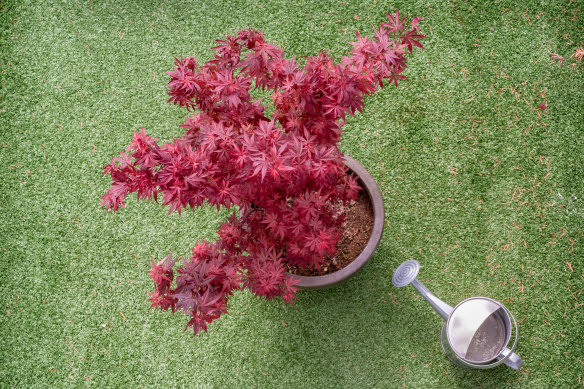[ad_1]
For now, it’s entirely predictable: the glare of summer will give way to the glow of autumn. Any moment and warm colour will start flaring up in our parks (thank you elm, ginkgo and plane), blazing through our streets (lipstick maples, pin oaks) and brightening our houses (Boston ivy, Virginia creeper).
The explosion of fiery foliage on plants that have been decades in the growing will invariably get many of us thinking about how we might introduce more of these flare-ups into our own gardens. Autumn colour envy is part and parcel of the season. And, happily for impatient gardeners, autumnal theatrics can be instant.

Japanese maple is a great option for those looking to pot autumn colours.Credit: iStock
But, at this point in the season, it will need to be contained to a container. Just as visitors to this week’s Melbourne International Flower and Garden Show might note that all the plants in all the display gardens are actually in cleverly concealed pots, anything is possible – for a time at least. Such autumn stalwarts as Japanese maple, crab apple, cotinus, oak leaf hydrangeas, enkianthus and berberis can happily spend their entire lives in (relatively roomy) pots and keep giving, autumn after autumn.
Ornamental grasses are another good container option, so long as you are prepared for the winter downtime after they are cut back close to the ground. Miscanthus sinensis cultivars are currently flowering and starting to turn from green to yellow-orange-coppery tones, while Turned into a panic cultivars, also now flowering, have foliage that will turn to red and gold before the season is out.
Loading
Alternatively, you can go small and make the most of tiny flashes of brilliance with a deciduous bonsai. Beeches, elms, the ginkgo and other such classic bonsai fare will get too big for many of us to accommodate at home, but by restricting these trees to life in a shallow, tray-like pot, they can fit almost anywhere. Some nurseries sell bonsai trees and shrubs that have been years in the training. They will burst into vivid colour any week now.
But this ancient Chinese and Japanese horticultural practice is not for the faint-hearted. What you might save in planning ahead of this autumn you will pay for with regular care from this time onwards. As with a pet, you can’t just turn your back.
There will be much snipping, pinching, watering, feeding, wiring, moving plants to suit the light and training plants to suit your eye. Because bonsai are kept in small pots, gardeners have little room for error, especially in an extreme heatwave like the one we experienced earlier this month. Do everything right, though, and a whole dynamic landscape can be evoked in miniature. Even a hemmed-in city courtyard can house gnarly, vibrant trees that look like they belong on mountaintops.
Another option is to embrace the fiery colours of the season in spirit, but not necessarily with the sort of trees, shrubs and climbers that sport flamboyant foliage only in autumn. The red, purple, orange and yellow leaves we see on some plants around this time of year stem from the plant’s dropping chlorophyll levels. It’s the chlorophyll that lends the leaves their green colour, and when days shorten and sunlight levels drop, this starts to break down, leaving other pigments that were always present to show themselves before the leaves fall to the ground.
[ad_2]
Source link
